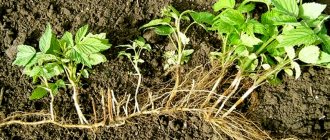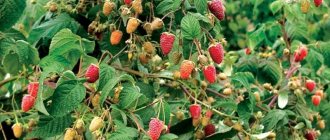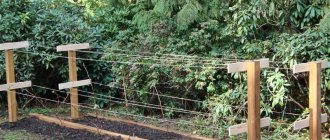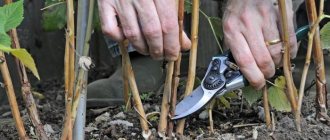In what cases are raspberries planted in the fall?
Autumn is considered the most favorable time for planting raspberries. During the time remaining before the cold weather, the seedlings have time to take root, the existing root system is not only strengthened, but also replenished with new roots.
Raspberries are planted in the fall if:
- The variety is winter-hardy. It is better to plant non-winter-hardy raspberries in the spring.
- The weather is favorable for autumn planting - this is especially true in the southern regions and temperate climates.
- We need to get the harvest as soon as possible. Having planted seedlings in the fall, the gardener receives the first berries in the summer. Raspberries planted in spring bear fruit only the following year.
We recommend reading the article about the best raspberry varieties.
Spring
Spring planting is practiced quite often, but the plant will take more time to take root and grow, which will also affect the beginning of fruiting. In the first year it most often does not happen.
It is important to carry out transplantation before the buds appear and sap flow begins. Depending on the region, this period will differ:
- Siberia, Ural, Leningrad region - early May;
- Middle zone, Volga region and Moscow region - end of April;
- South – end of March – beginning of April.
Among the advantages of spring planting, the following points are most often mentioned:
- Active growth of the root system throughout the warm season and better preparation for winter.
- Sufficient time for rooting and the beginning of growth before the arrival of summer heat and drought.
- No risk of freezing during the cold season.
- The growth of the seedling coincides with the natural start of the growing season in plants.
- Melting snow provides good soil moisture. This has a positive effect on the adaptation of the root system to new environmental conditions.
Related article:
So that raspberries bear fruit well
The disadvantages of the chosen procedure include the lack of fruiting in the current season and a large amount of work in the garden and in the garden, which requires additional labor costs and time from the summer resident.
Planting dates in different regions
The time for planting raspberries in the fall is chosen taking into account the climate in the region. The seedlings should have enough time - at least 3-4 weeks - to take root well.
Features of autumn planting of raspberries in the regions:
| Region | When to plant? | Note |
| Middle zone and Volga region | From September to October | Here raspberries can be planted at any time, but it is autumn planting that makes them stronger and more resilient. |
| Northern regions, Siberia and the Urals | Until the first days of September | It is important to focus on current weather conditions. If it is cool and damp at the end of summer, it is better to postpone planting to spring. Autumn planting in this case threatens death and fungal diseases. The rows must be arranged from north to south. |
| South and southern regions | From mid-September to November | The seedlings have time to take root well and grow stronger. |
According to the lunar calendar
Today, many gardeners, when doing work in the garden, are guided by the lunar calendar. Agrotechnical measures carried out on favorable days are more effective.
According to the lunar calendar for 2021:
- Favorable autumn days for planting raspberry seedlings are September 1-4, 7-9, 17-19.
- Unfavorable days – 10-11, 14, 20-22, 24-25, 28 September.
Choosing a deadline
Each gardener, based on his own experience and the region where the berries are cultivated, independently decides when it is best to plant raspberry seedlings, since this procedure is successfully carried out both in autumn and in early spring.
For successful growth and development, it is important to correctly determine the optimal planting period. You should not hold the event in the last suitable days, too early in the spring or late autumn. Such haste will negatively affect the growth of the bush - it will grow weak, susceptible to diseases and pests, or die altogether.
Related article:
Raspberry leaves turn yellow: causes and solutions
Experienced gardeners also recommend determining the timing based on the location of the berry cultivation area:
- South of the country – autumn;
- Siberia, Ural - spring and autumn.
When choosing a planting time, you should not forget about such important points as the weather conditions of the region, soil quality, predicted precipitation and decreased air temperature.
Advantages and disadvantages of autumn planting
Why is it beneficial to plant raspberries in the fall:
- At this time, there is a lot of planting material on the market at an affordable price - you can choose any variety you like. Seedlings are often sold with berries so that the buyer can see what he is buying. In spring there is always less choice.
- The weather in autumn is not hot, the humidity is high, and the temperature drops at night. Such weather conditions activate root growth in seedlings. In spring, the weather can change dramatically; temperature changes from hot to cool negatively affect the growth of newly planted seedlings. In autumn there is no such problem.
- Easy care. After planting, the seedlings require a minimum of care - the main agrotechnical activities are postponed until the spring.
- In autumn, the seedling accumulates nutrients and the plant strengthens. A seedling planted in the spring spends energy growing green mass, and at the same time it still has to take root. Due to this energy consumption, spring seedlings are weaker than autumn ones.
Autumn planting has one drawback - you need to vigilantly monitor the weather so as not to make a mistake with the planting time. It is not always possible to accurately guess the best time.
Further care for raspberries after spring planting
So, now you have planted raspberry seedlings. What to do next? How to care for them after planting?
Immediately after planting, it is imperative to trim raspberry seedlings to a height of 15-25 cm, if they have not already been trimmed by the seller in advance (as a rule, these are the ones they sell or send).
If this is not done, then the raspberry will spend a lot of energy on the leaves and buds that form on the high stem, which will greatly deplete its already weak roots. As a result, the seedling will noticeably lag behind in development: it simply does not form a good root system and a sufficient number of replacement buds (from which shoots should appear next year).
Next, it is very advisable to mulch the tree trunk circle of raspberry seedlings. Mown grass, hay, straw or rotted sawdust are perfect for this.
Why is this (mulching) necessary:
- After heavy watering, a dry crust often forms. Thanks to mulch, the soil will always be loose and moisture will be retained longer.
- Weeds, which raspberries do not like so much, will not grow under the mulch.
- Mulch is an excellent organic fertilizer.
- Of course, we must not forget about watering .
Any raspberry loves watering (especially remontant ones), and it must be watered very generously.
- No fertilizing will be required in the next 2-3 years, of course, if you have added a sufficient amount of nutritious soil and fertilizers to the planting holes before planting.
- And in the fall you will need to prepare the bushes for winter .
Advice! How to care for raspberries in the fall and properly prepare them for winter is described in detail in this article .
In the future, the main measures for caring for raspberries will include the following:
- Annual pruning after fruiting (autumn) or early spring .
The main pruning of raspberries is carried out, as a rule, after fruiting (in the fall) , and in the spring only corrective, or rather sanitary, pruning is done.
Of course, if you did not have the opportunity to prune raspberries in the fall, then it is better to prune in the spring than not to prune at all.
- shoot garter;
By the way! You can read about how to properly tie raspberries in spring and autumn in this material .
- fertilization;
Advice! The site already has detailed materials about spring feeding of raspberries , as well as about autumn .
- treatment against diseases and pests.
Important! About what and how to spray raspberries in the spring is written in detail in this article .
- If the raspberries have grown too much, then they should definitely be planted and replanted .
By the way! Read about how to do this correctly in spring, summer or autumn here .
How to limit the proliferation and spread of shrubs throughout the area when planting, so as not to suffer later
Very simple. If you want to limit the growth of raspberries, then between the rows you should bury sheets of slate, old roofing iron or similar material to a depth of 40-50 centimeters.
As an option, you can make a warm bed with a slate fence.
What conditions are needed?
For autumn planting to be successful, several conditions must be met, here are the most important:
- Take only annual seedlings.
- Select the site carefully - it must meet the requirements of lighting, soil composition, etc.
- Stock up on water - you will have to pour 8 liters under each bush.
- Check the quality of planting - if, when pulled out, the seedling rises easily, replant it, otherwise it will freeze.
- Select the planting time so that there is about a month left before frost - so that the roots take root and the buds do not have time to awaken.
- Planting is carried out at an air humidity of 80% and at a temperature of 10-15°C.
When to plant raspberries?
Raspberries can be planted in autumn (September-October) and spring. For raspberries, you need to choose a well-lit area, since this berry is light-loving, and if you plant it in the shade, the young shoots can become very elongated and shade the stems with fruits. As for the composition of the soil, each variety has its own preference in this matter, but in most cases light fertile soils are suitable for raspberries, although they grow normally on both black soil and loam. The pH value optimal for raspberries is 5.7-6.5. Neither lowland nor elevated areas, nor steep slopes are suitable for growing raspberries, since moisture often stagnates in the lowlands and areas with uneven terrain, and on the hills, on the contrary, it will lack moisture. It is best to plant raspberries on level or slightly sloping areas. In one area, raspberries can grow for seven to ten years, and then you will need to change their place, since over such a period of time the soil under the raspberries will be depleted. The next time it will be possible to plant raspberries in this area again no sooner than in 5-7 years. Areas where nightshades (tomatoes, potatoes, peppers) previously grew are absolutely not suitable for growing raspberries. The best predecessors are legumes or grains.
How to choose seedlings?
You cannot count on good harvests without high-quality planting material. What are the criteria for selecting annual raspberry seedlings?
- developed root system;
- root length – 10 cm;
- flexible shoots about 1 cm thick at the base;
- there should be no signs of rot on the roots.
Take seedlings with closed roots. Such planting material is usually offered by nurseries and garden centers. Raspberry seedlings grown in separate containers are transplanted using the transshipment method - along with a lump of earth. The survival rate of such seedlings is almost 100%.
Photos and descriptions of raspberry varieties for the Leningrad region
Today there are many varieties of raspberries that can be grown in the Leningrad region. All of them give good yield.
However, you need to choose among these types:
- early ripening;
- mid-season;
- late ripening.
It is worth considering several popular varieties that are currently grown in the Leningrad region.
Choosing a landing site
Requirements for a site for planting raspberries:
- Lighting. Good sun exposure. It is advisable that the sun's rays fall on the site most of the day. You can’t plant raspberries between fruit trees - aeration and lighting deteriorate, and yields drop.
- Relief and humidity. Raspberries are badly affected by drafts and wind, so it is better to plant them closer to the fence, retreating at least a meter. Slopes where the soil can dry out are not suitable for planting. The culture is moisture-loving, but does not tolerate excessive waterlogging - the roots rot. Raspberries should not be planted in lowlands where water stagnates. The groundwater level is at least 1.5 m from the surface.
- Neighborhood. The best neighbors are currants and blackberries. It is undesirable to place a raspberry garden next to competing crops - grapes and sea buckthorn.
When choosing a place for planting, it is necessary to take into account crop rotation:
- The worst predecessors for raspberries are nightshades (eggplants, potatoes, tomatoes) and strawberries (strawberries).
- The best predecessors are pumpkin, zucchini, cucumbers, beans, green manure.
The following video talks about the best place to choose for planting raspberries in the fall:
Raspberries can be replanted in the place of the former raspberry field after 4-5 years.
How to plant correctly: a step-by-step guide
The development of the bush and its productivity depend on the correct procedure for planting a raspberry seedling, so it is necessary to carefully study not only the instructions for planting bushes, but also pay attention to the features of choosing a place for growing, preparing the soil and seedlings for planting.
Selecting a location and preparing a seedling
Raspberries are a light-loving plant, so the seedlings are placed in an area with direct sunlight and no shade. A flat area or area with a slight slope (3–5°) is optimal for growing raspberries, so all parts of the plant will be maximally illuminated and warmed up.
Raspberries should not be planted in lowlands, depressions or quarries where there is a risk of flooding and a high level of humidity is constantly maintained. In such places, plant growth slows down, fungal diseases develop, and productivity decreases. Groundwater should not come closer than 1.5 m to the soil surface, otherwise the root system will be constantly waterlogged and will begin to rot and die.
To mitigate the impact of strong winds on the raspberry tree, it is better to place protective plantings in the form of evergreen shrubs, low buildings or fencing in the northern part of the site. This measure is necessary not only to protect raspberries from freezing in winter, but also for normal pollination of flowers by bees during the period of active flowering.
The soil in the raspberry patch must have a composition suitable for the normal development of plants. It is better to choose soil that is fertile and nutritious, with a light loose structure. It is optimal to plant bushes on sandy loam soils, loams, chernozems, gray forest soils, soddy-podzolic soils, with a neutral or slightly acidic reaction. It is strictly not recommended to choose a site with marshy, calcareous, saline, or dry sandy soil for planting raspberries.
Did you know? Modern breeding makes it possible to create new raspberry varieties with amazing colors. So, there are yellow, red, black and even purple raspberries, which were developed in the USA back in 1896.
If you buy a high-quality seedling, you will not need any special preparation for planting. A young plant should have 2-3 strong shoots, a well-developed root system, with a long central root and a large number of smaller shoots. If you do not plan to plant a seedling immediately after purchasing, it is better to bury it so that the root system does not dry out.
Preparing the soil and holes
Preparing the site for planting raspberries should be carried out in order to create an optimal water-air regime, remove weeds and provide the soil with nutrients that will stimulate good plant growth.
If you start preparing the site for planting raspberries in advance, you can sow green manure plants, which, after growing, are embedded in the soil and left to enrich the soil with humus. If there are time restrictions, apply manure in the amount of 40–50 t/ha.
Particular attention should be paid to ridding the area of weeds; wheatgrass, bindweed and thistle are considered very dangerous neighbors for raspberries. To clear the area of weeds quickly and without much labor, continuous action herbicides are used.
2 weeks before the planned date of planting the seedlings, preparation of the holes begins. To do this, dig holes measuring 50 cm in diameter and 40 cm in depth. In the process of digging up the soil, the top layer is separated from the bottom, which will then be used in a certain sequence.
Important! The period for planting raspberries after treating the soil with herbicides will depend on the product used, so carefully read the instructions before performing the procedure.
A nutrient mixture consisting of:
- compost or humus - 10 kg;
- potassium sulfate - 50 g;
- wood ash - 400 g;
- granulated superphosphate - 100 g.
Landing
Before planting seedlings in prepared holes, the composition inside the holes should be loosened. If planting is carried out in the autumn, it is recommended to add a 10-centimeter layer of fertile soil to the holes. In order for the plants to grow well and have enough free space to grow additional fruit shoots, it is necessary to follow the planting pattern: leave 50-70 cm between seedlings, 1.5-1.8 m between rows.
Planting should be done as follows:
- Place a raspberry seedling in the hole and spread the roots in different directions.
- Sprinkle the roots with the top layer of soil (fertile) that remains after digging the hole.
- Soil should be poured until the hole is completely filled and the replacement bud rises 2–3 cm above the surface.
- Lightly compact the soil around the bush, make a shallow groove around the trunk circle and pour 5 liters of clean water at room temperature into it.
- The space around the bush should be mulched with straw, sawdust or humus, in a layer of 5 cm.
Soil requirements
Raspberries love fertile soils. If the soil is poor in nutrients, the raspberry leaves turn pale and turn yellow. When choosing and preparing the soil for planting, consider the following:
- Loams. The best option. These soils retain water well. Humus is added to them and high-quality drainage is made from expanded clay - the result is ideal soil for raspberries.
- Sandstones. Also a great option. Well-permeable soil in which water does not stagnate.
- Sandstones. Raspberries grow well on sandy soils, but only if they are fertilized and regularly watered.
- Clay soils. An undesirable option is that raspberries grow weak and unproductive on clay soils. Sand is added to clay soil - a bucket for 1 square meter. m.
The relationship of raspberries to soil acidity:
- The optimal soil acidity is neutral.
- Add lime to acidic soils - 0.5 kg per 1 sq. m.
- Alkaline soils are unfavorable. Therefore, you should apply chalk and ash with extreme caution - they, by alkalizing the soil, can provoke root canker. Gardeners often add ash during the formation of berries to improve their taste.
You can find out the approximate acidity level in a simple way - by observing the growth of weeds. On highly acidified soils, plantain, sorrel, horsetail, and fireweed grow especially rapidly. On neutral soils there is a lot of clover and nettles.
How to properly plant raspberries in a planting hole or trench in spring
Before planting seedlings, you first need to decide on a suitable location on the site. It also doesn’t hurt to learn about the basic rules for placing raspberries and choosing a planting method. And, of course, choose quality seedlings.
What should a seedling be like?
When choosing a seedling, you should pay attention to its root system; it should be well developed.
A high-quality seedling has a developed fibrous system, 10-15 cm long.
Advice! If you are planting raspberries for the first time, then it is better to purchase seedlings with a closed root system, that is, at least in the ground, and preferably in pots.
If you purchased seedlings with an open root system, then immediately before planting, carefully examine the roots of the seedlings, cut off all dry and rotten parts, and then dip them in a clay mash.
Landing location
It is recommended to select a place in advance for planting raspberries. It should be open and sunny, but closed on the north side from drafts and cold winds.
If raspberries remain in the shade for a long time during the day, the ripening dates may shift to later. For the same remontant raspberries, this is very bad, because the berry may simply not have time to ripen.
Although raspberries love abundant watering, they do not tolerate prolonged stagnation of moisture. Therefore, shrubs cannot be planted if groundwater lies closer than 1 meter.
You cannot plant raspberries in a place where raspberries also grew before. The fact is that spores of fungal diseases and pest larvae could remain in the soil.
Also, raspberries are not planted after strawberries, because they have one common pest - the raspberry-strawberry weevil .
What kind of soil is needed
Raspberries love fertile soil.
However, you can grow it in both sandy and clay soils, although, of course, ideally it should be loamy or sandy loam soil.
In any case, on poor soils you will hardly be able to get a rich raspberry harvest, so when planting, depending on the fertility of your land, you will need to apply mineral and organic fertilizers.
The optimal soil acidity for successfully growing raspberries is 5.5-6.5 pH (slightly acidic-neutral).
On alkaline or acidic soils, raspberries will simply sit and not develop and bear fruit.
Distance between bushes and rows
Raspberries are planted in such a way that there is a distance of 50-80 cm between the bushes (depending on which variety is vigorous or not), and between rows - 1.2-2 meters.
This distance allows you to conveniently harvest and care for berry bushes. In addition, plants planted at such a distance do not interfere with each other, and they have enough nutrition.
Planting pit and planting depth
As a rule, a hole 40-50 cm deep is dug for planting raspberries. At the same time, its width and length, as a rule, are also the same 40-50 cm. These dimensions of the planting hole allow you to add all the necessary organic and mineral fertilizers required for active growth and abundant fruiting of berry bushes.
The seedling itself is planted so that the root collar (replacement buds) is ultimately at soil level.
Direct landing
Step-by-step instructions for planting raspberries in spring:
- Place the seedling in the center of the planting hole or trench on a small mound, and then carefully and evenly spread its roots.
Interesting! Some experts recommend planting raspberry seedlings with an open root system directly into the slurry, in other words, you first need to generously spill the hole or trench with water. You can try this too.
- Sprinkle with fertile garden soil mixed with humus (2 to 1).
When filling with soil, it is recommended to slightly lift the seedling several times so that the roots come into better contact with the soil and no voids form around them.
As a result, the root collar (replacement buds) should be at soil level.
- Compact the soil around the seedling.
- Sprinkle generously with water (5-10 liters) to ensure maximum contact between roots and soil.
- The landing is complete, but there are a couple of nuances remaining, which will be discussed later.
Video: planting raspberries in spring
Are there any differences in planting and caring for remontant raspberries?
The whole difference between remontant and regular raspberries is that remontant raspberries can bear fruit both on the shoots of the current year and the previous one, i.e. instead of one harvest, you can get two (1 time - in June-July, 2 times - in August-September).
However, it is worth knowing that the second (autumn) harvest of remontant raspberries is less tasty, while the first (summer) harvest is not inferior in taste to regular ones.
However, it makes sense to have both regular and remontant varieties on your plot in order to collect tasty and healthy berries both in summer and autumn.
Naturally, remontant raspberries are more demanding of light, watering and fertilizing than ordinary ones, which is quite logically explained by their greater fertility.
Video: features of planting and caring for remontant raspberries
Correct distance between bushes
Enough space is left between the raspberry bushes so that they grow comfortably, are well lit, ventilated, and are accessible for care. The distance between bushes depends on the planting method:
- If raspberries are planted in rows, there should be at least 70-100 cm between adjacent seedlings. Between rows - 1-1.5 m. It is allowed to plant no more than 2 seedlings in one hole.
- If the tape method is used, the step in the rows is 35-50 cm. The distance between the tapes is 1.8-2 m.
Planting remontant raspberries in open ground in autumn
Remontant raspberry varieties should be planted only in well-lit areas. Throughout the daylight hours, the bushes should be exposed to sunlight: the fruiting of the plant depends on this. Choose places that are reliably protected from drafts.
Site selection and soil preparation for remontant raspberries are the same as for conventional varieties. But there are 2 more ways to plant these varieties:
- On the trellis. Often the support is a fence, a stretched mesh and other devices.
- Curtain method. 2-3 seedlings are placed in one hole. This is suitable for weak planting material.
The timing of planting remontant raspberries is variable, depending on the region and weather forecast. It is important that there is at least 1 month left before the onset of frost.
Raspberries should be fertilized (fermented barnyard (1 kg per 10 liters of water) or chicken droppings (1 kg per 20 liters). And, preparing for winter, covered with mulch.
You can plant:
- Saplings. They are deepened in the garden 4 cm more than it was in the nursery - the root bud must be covered.
- Root suckers. The root shoots are dug up along with a pile of earth, holes are made 25–30 cm deep, a “nettle” (root shoot) is placed inside, the material is sprinkled with earth and watered.
- By cuttings. They dig up adult bushes and select the roots, the thickness of which is 5 mm: they need to be cut. The optimal cutting length is 15 cm. Furrows appear in the formed area, into which the cuttings are placed. Planting is carried out using the chain method, planting material is deepened by 4 cm.
Planting methods and instructions for them
Raspberries are most often planted using bush or trench methods. Farms usually use the belt method. Let's look at all three methods in more detail.
Bush
This planting method is used in regions with high humidity. Thin raspberry bushes promote good ventilation of the bushes and reduce disease incidence. The bush method does not require preliminary fertilization of the soil.
Step-by-step instruction:
- 2 weeks before planting, dig holes 40 cm deep. The diameter of the holes is 30-40 cm.
- Add 5 kg of humus or compost to each hole.
- Prepare a mixture of 1/2 of the excavated soil and fertilizers - superphosphate (20 g) and potassium sulfate (10 g). You can replace the latter with two glasses of ash.
- Fill about half of the hole with soil mixture.
- Place the seedling in the hole, spreading the roots in different directions.
- When burying the roots, make sure that the root collar of the seedling does not end up below the soil level.
- When filling the roots with soil, shake the seedling periodically so that there are no voids left between its roots.
- Form a circular hole around the seedling and pour 5 liters of water into it.
- Shorten the shoots; their height should be about 20 cm.
- Mulch the soil with hay, straw or humus.
This video shows autumn planting of raspberries, in which you can get a very good harvest next season:
Tape
Planting using a strip or single-row method is somewhat more complicated than the bush method, but it is the most popular method for growing raspberries over large areas.
Step-by-step instruction:
- Dig a ditch - a “ribbon”, 40-50 cm wide. Depth - from 40 cm. Length - at your discretion.
- Apply fertilizer to the ditch and mix it thoroughly with the excavated soil. Fertilizer application rate per 1 sq. m:
- rotted manure – 3 kg;
- superphosphate – 30 g;
- potassium salt – 20 g.
- Place the seedlings at a distance of 45-60 cm from each other. The interval between rows is 1.5-2 m. When choosing a planting scheme, take into account the height of the bushes - it depends on the variety. If the raspberries are tall, make maximum intervals.
- Plant the seedlings so that their roots are vertical, without bending. Seedlings planted using the strip method form an even line.
In addition to the single-row method, there is also a two-row planting method. It is almost no different from the previous one, but the bushes are planted in a ribbon in 2 rows:
- In the tape, the rows are located at a distance of 40-80 cm from each other, depending on the tallness of the variety.
- The interval between seedlings is the same as with the single-row tape method - 40-50 cm.
The main advantage of the two-row method is space saving.
Trench
The trench method is a type of strip planting. Its main difference is the nutrient cushion placed at the bottom of the trench. The pillow has been a source of nutrients for the raspberry plant for a long time. And thanks to the decomposition of plant residues, the bushes receive additional heat.
Step-by-step instruction:
- Dig a trench 40-50 cm wide. Depth – 60-70 cm.
- If the soil is heavy, clayey, lay gravel and sand in a layer of 10-15 cm at the bottom of the trench. Then lay a cushion - first branches, then fallen leaves, hay and green mass. To ensure uniform “ripening” of the layers, you can cover them with sawdust or fertile soil.
- Water the layers of plant debris well.
- Place a soil mixture of fertile soil, organic matter and mineral fertilizers on top - prepare it in the same way as described above. Next, the seedlings are planted - the same as with the tape method.
Only healthy shrubs and trees are used as a plant base for the nutrient cushion.
Regardless of the planting method chosen, it is recommended to fence off the edges of the planting. To do this, slate or boards are buried in the ground - this will prevent the raspberries from spreading across the area.
In this video, the gardener shares his experience of autumn planting raspberries using the trench method:
Industrial planting of raspberries
To plant raspberries over large areas, root suckers are used, which are specially grown in nurseries. To locate raspberry plantations, gentle, flat slopes are selected (slope no more than 5°), protected from the prevailing winds. But protective plantings should not shade the berry bushes.
Raspberries are grown on an industrial scale
Work is carried out in autumn or early spring. When plowing, fertilizers are applied to the ground at the rate of 1 hectare:
- organic - 150 t;
- potash - 0.3 t;
- phosphorus - 0.2 t.
Planting is carried out using the belt method using special machines (SLN1 and SSHN3) according to the following scheme:
- row spacing - 1.5–2 m;
- distance between seedlings - 0.3–0.5 m;
- embedment depth - 0.2 m.
Then the young plantings are mulched with peat - 15–20 tons per 1 ha.
Planting raspberries is carried out using special planting units
Industrial cultivation of raspberries in our country is currently poorly developed. But during the Soviet Union, there were large raspberry fields in every fruit nursery. After the harvest, ordinary citizens were released onto the plantations, who could pick the remaining berries on the bushes and then buy them for next to nothing.
Video: industrial method of planting raspberries under film
Care after landing
Care consists of maintaining normal soil moisture and preparing plantings for winter. In order to carry out all autumn agrotechnical measures on time - before frost, it is necessary to monitor the weather.
Do I need to water?
During planting, water the raspberries, then you need to pause - without additional moisture, the root system of the seedlings will grow and develop better. In many regions, the weather is rainy in the fall - watering planted raspberries is definitely not required there. And only some time after planting, if the soil is dry, the seedlings are watered.
Before winter, experienced gardeners recommend water-recharging watering - it makes the shrub more frost-resistant. The soil should be moistened 40 cm deep.
Do you need feeding?
No fertilizing is needed in the fall - the plant received all the useful organic substances, as well as potassium and phosphorus, during planting. The plant is provided with nutrition provided during planting for 2-3 years.
If raspberries are planted in unfertilized sandy soils, you can apply fertilizer immediately after planting. Between the rows, grooves are dug 15 cm deep - along the entire length of the row. Fertilizers are applied at the rate of 40 g of potassium salt and 60 g of superphosphate per plant. First, the required amount of fertilizer is poured into the furrows, and then they are filled with water so that the minerals dissolve.
Mulching
Autumn mulching is used from the first year of raspberry life. The mulch is scattered immediately after planting - in a thin layer, and immediately before frost, a thick layer is poured. Thanks to this procedure, the root system is protected. This is especially important in the absence of snow cover.
For mulching, organic materials with a neutral acidic environment are used.
Organic mulch for raspberries:
- Peat. The perfect solution. This organic matter of “swamp” origin is most suitable for raspberries. It can be laid even on unexpectedly fallen snow. For winter shelter, a layer 5-7 cm thick is sufficient.
- Sawdust. This affordable material is more popular among gardeners than others. Sawdust turns into humus in 2-3 years
- Compost. It is less suitable than others for autumn mulching of raspberries due to its high nitrogen content.
You can also use straw and rotted leaves as mulch - they are usually used before wintering.
Preparing for winter
In the southern regions, raspberries planted in the fall do not need to be covered - just mulching is enough. In the middle zone and in the northern regions, the future raspberry tree is covered for the winter. The shelters installed are designed for snow to fall in winter and protect the seedlings from frost. Plants that are not covered are at risk of freezing.
The procedure for preparing young raspberries:
- If there is no rain, water the plantings.
- Loosen and mulch the soil with a thick layer of organic matter - peat, dry leaves, spruce branches. Mulch protects the roots from freezing and at the same time provides a source of nutrients. The mulch layer should be 5-10 cm thick, otherwise it will have no effect.
If the variety is not frost-resistant, or winter temperatures in the region are very low, you will have to bend the seedlings to the ground. This is done a week before frost. Seedlings should be bent down very carefully. They are laid on one side and fixed. In winter, snow is thrown over the raspberry field.
Features of autumn planting raspberries: pros and cons
Planting raspberries in the fall has several advantages. By the end of the season, most of the gardening work has already been completed; you can slowly prepare a place for a raspberry tree and select high-quality planting material.
The main thing is to plant the plants 3 weeks before the first frost. In the spring, it is not always possible to plant before the buds swell, because raspberries wake up very early and begin to grow, without having time to develop a strong root system. As a result, plants take a long time to take root, and underdeveloped roots are not able to fully provide leaves, shoots with moisture and nutrition. Return frosts are also common, which can destroy fragile seedlings. In the southern regions, where dry, hot weather sets in very early in spring, young shoots often dry out.
After autumn planting, overwintered seedlings are ready by spring to grow the above-ground part and form a crop. Bushes planted at the beginning of the season will bear fruit later.
However, in a cold and rainy autumn or if there is a threat of early frosts, it is better to postpone planting bushes until spring, since they will not have time to take root and may die. Therefore, in northern regions with a harsh climate, it is better not to take risks and begin planting work with the onset of spring warmth.
Popular mistakes made by newbies when landing for the first time
Errors in planting, due to which it is not possible to get a large harvest:
- The raspberries were planted too early. Having taken root, the seedlings have time to send out shoots. Once activated, the plant may suffer during the first frost, and its immunity will be lowered.
- The raspberry plant is located in a shaded place. Due to the lack of sun, the plant reaches for the light, its shoots become thinner, and they do not have time to ripen by the end of the season. Because of this, in winter, part of the buds - at the ends of the shoots - freezes.
- The raspberries are planted on clay soils where moisture stagnates.
- During planting, seedlings are poorly pruned. The above-ground part delays nutrition, interfering with rooting.
- Low-quality seedlings were used - too mature, with dry roots, with defects, traces of diseases (a description of raspberry diseases is written here), damaged by insects.
Spring
If a dilemma arises when to plant this plant: in autumn or spring, you need to take into account climatic conditions. In many regions, spring planting is preferred. But it also has its own characteristics. If warm weather sets in quickly, sap flow begins and the first leaves appear. Because of this, transplanted bushes take a long time to take root. This type of planting is not suitable if the spring is very dry, the plant simply does not have enough moisture and it will die. But it is often used, especially when propagating new varieties by seedlings.
Important! When planting in spring, it is recommended to cut the shoots low, to the buds that have not yet blossomed.
When should I expect fruiting after planting?
Receiving a harvest in the first summer is one of the main advantages of autumn planting. But for this advantage to be realized, it is necessary to provide the seedlings with proper care. If the young growth suffers from a lack of water, freezes in winter, and is affected by pests, then next year’s harvest will be meager or the raspberries will not produce berries at all.
Conditions for harvesting next year:
- correct planting - healthy planting material, application of fertilizers, etc.;
- ensuring normal soil moisture;
- careful shelter for the winter - in accordance with winter temperatures;
- treating the soil under the bushes with Karbofos - 10 ml per bucket of water (calculated for one bush);
- treat the soil with a solution of copper sulfate - from fungi and lichens.
If the seedlings survive the winter safely and receive proper care in the spring, the first berries will appear in July-August - depending on the ripening time of the variety.
The most difficult thing in autumn planting of any crop is choosing the right moment. If the planted raspberries open their buds before frost sets in, you won’t have to count on a harvest. Otherwise, planting raspberries in the fall is simple and represents a standard set of agrotechnical measures.
1
0
Copy link
Conditions for landing
It is necessary to plant raspberries correctly. This usually happens in autumn or spring . Each season has its own advantages. Regardless of the time of planting, there are certain requirements that must be met. This will allow the bush to acclimatize faster and begin to grow.
How to plant raspberries correctly:
- Dig holes or trenches. Their depth should be at least 50–60 cm. The root system must be placed completely underground. The width of the hole/trench is the same.
- Then organic fertilizers are laid out. It is better to use humus, as it will not harm the young root system. One bush needs about 5 kg of fertilizer.
- Then the bush is planted, buried and compacted.
- At the end, you need to water the raspberries at the rate of 10 liters per bush.
Sometimes gardeners first pour water into the hole and then plant a raspberry bush. This method is also practiced and has its advantages. In particular, the root system will be in the ground.
What can be used in the form of raspberry seedlings
Overgrowth
Raspberries should be planted with young, one-year-old shoots - root shoots (shoots). They appear at the beginning of the season a little away from the mother bush, grow and develop during the summer, and are easy to separate in the fall. Reproduction by adult, large plants or by dividing a bush is a big mistake; they take root poorly and hardly grow back in the future. The quality of seedlings should be given special attention - regardless of whether they are your own or purchased. This is an important factor that determines the fate of the plantation for many years to come.
Roots
By autumn, the raspberry shoots should have formed a good root system: in high-quality seedlings it is branched, fibrous, with many feeding roots. A less lush underground part is characteristic of some varieties of standard large-fruited raspberries (such as Tarusa), raspberries, and blackberries. Bare taproots tend to form in poor, compacted soils. Plants with such roots take root less well; even if they have overwintered, they develop slowly in the first year. From the moment of digging up to planting, the raspberry root system should not dry out; It’s also not worth keeping it in water: you can dig it in (in a shady place), sprinkle it with earth or wet sawdust, cover it with a damp cloth or wet newspapers and wrap it in plastic. If treatment has been carried out with a clay mash, it must be washed off before planting. There are hot days in autumn; seedlings should not be left in the sun.
Stem
It is believed that the optimal thickness of the above-ground part of a raspberry seedling is no less than a pencil. In principle, this is true - thin, frail shoots should not be chosen for planting. The thickness of the raspberry stem (as well as its color) largely depends on the variety; if it is characterized by thin flexible shoots, this in itself is not a disadvantage. By autumn, the trunk of a strong seedling should ripen, not be soft and bright green. A high-quality root collar is strong, with visible rudimentary buds (they are not always visible only in super-large-fruited varieties).
Root cuttings
The underground part of the raspberry bush contains many dormant buds. Being separated from the mother plant, they are able to awaken and send out shoots in the summer, giving life to new bushes. Autumn is a very suitable time for this method of reproduction. Rhizomes half a centimeter thick are taken from dug up shoots or from very young bushes, cut into pieces approximately 10 cm long and planted horizontally to a depth of 7 cm.
Visual step-by-step planting instructions
Planting seedlings involves the following sequence of procedures:
- the seedling is lowered into the prepared hole and placed in the center;
- You can’t bury raspberries, but you shouldn’t plant them on the surface either, otherwise it threatens to dry out the root system;
- they begin to fill the hole with soil, straightening the roots and making sure that the earth fills all the space between them;
- the earth is slightly compacted and compacted;
- water the raspberries generously;
- the substrate is covered with mulch, for example, sawdust or peat;
- seedlings are pruned, leaving a height of twenty centimeters.
Video: trench method of planting raspberries
Site selection and soil preparation
Raspberries love sun and fertile soil. You need to look for a place for it, taking these two factors into account. A dark place is not suitable for growing raspberries. Even if the only free piece of land is darkened, you should not plant it there. Simply because the results of such plantings will not please you. There are few berries in the shade, and those that exist are small and tasteless.
Buds in the shade form mainly on the tips of non-lignified shoots, which will need to be pruned or they will die in winter. This will adversely affect the raspberry harvest. For the same reasons, the raspberry bush should be closed from northern winds so that the bushes do not freeze in winter. It is better to place trenches with seedlings from north to south or from northeast to southwest. This way they get more sun during the day.
In addition to the sun, raspberries love fertile and loose soil. It can grow in sand or sandy loam soil. But in this case, to get a good harvest, she will need more care. Sandy soil should be watered every day in hot weather. Fertilizers must be applied more often than on other soils.
Loams are best suited for raspberries; they retain moisture longer. If humus and drainage (for example, expanded clay) are added to such soil, then it will be almost ideal in composition. You can also grow raspberries on clay.
According to its pH acidity, the berry loves neutral or slightly acidic soil, but not alkaline. Therefore, when fertilizing, be careful when adding ash and chalk, as they alkalize the soil, which leads to the occurrence of root canker. It is believed that ash improves the taste of berries. It can be used during fruit formation.
Transplanting raspberries to a new place in the fall
When to replant raspberries in the fall
Experienced gardeners know that after five years, raspberry fruiting becomes scarce, the size of the berries decreases, and the taste deteriorates. This is evidence that the plant does not have enough nutrition - in five years the soil has been depleted, and the raspberry tree needs rejuvenation, that is, replanting to another place. We have already told you how to choose a new site for a raspberry garden and how to prepare it. Now we need to determine the timing of the transplant.
Professionals believe that raspberries can be replanted from spring to autumn, but practitioners are inclined to believe that in warm areas and in the middle zone it is better to transplant raspberries to a new place in the fall.
When to replant raspberries in the fall? At the same time as the initial planting of raspberries - from mid-September to mid-October. Raspberry bushes are dug up in the fall, young viable shoots that have not yet bear fruit are separated from them for transplanting to a new site, thin, weak shoots are removed from them, the roots of the seedlings are disassembled and replanting begins. Strong root cuttings are also suitable as seedlings. You already know how to plant seedlings in the ground.
Preparing for winter
Preparing for winter is a very important time when it is important not to miss or forget anything. Schedule the following procedures:
- watering in case of lack of rain;
- mulching;
- pruning shoots or bending them to the ground;
- covering with spunbond or lutrasil.
No more than seven shoots are left on one adult plant so that they do not take food from each other, but develop and bear fruit normally. The mulch is turned over several times, especially if it is straw or hay.
As the weather gets colder, keep an eye on precipitation. As soon as the snow falls, use it to cover the raspberries. In winter, from time to time you need to ensure that the wind does not blow up the snow shelters. Raspberry shoots should be under snow cover to prevent the buds from freezing.
Planting raspberries should be done according to all the rules, so you will lay the foundation for an excellent harvest. Raspberry is a very unpretentious plant. But even he needs favorable conditions for abundant harvests.
The best raspberry varieties for planting in the fall
In order for raspberry bushes to take root better and faster, it is worth selecting those varieties that have a shorter period of bud development. This also includes low-growing raspberry varieties. Among them:
- Hercules. Remontant variety. Slightly spreading. The height of the shoots is 2m. Produces harvests in autumn and early summer;
- Reliable. A stable variety of remontant raspberries. He is not afraid of changes in the weather, he tolerates winter well. At very low temperatures, the branches of the bush should be bent and covered with snow;
- Penguin. A low-growing variety (120-140cm in height) of remontant raspberries. The shoots are powerful. The bush can withstand frosts down to -25⁰;
- Diamond. High-yielding variety of remontant raspberries. It tolerates not only cold, but also short-term drought.
These varieties grow faster, produce ovaries more often, and withstand winter more easily.
What else would you add to this article? If you have valuable experience and knowledge, we are all interested in hearing from you. Leave a link to the article on social networks and share with your friends so that they too can have their own raspberry garden!
Do I need to prune raspberries when planting in the fall?
After finishing planting, water the seedlings well and mulch with manure (if any) or fallen leaves and straw. If you plant raspberries in the spring, then immediately after planting you need to trim the seedlings to a height of 15 - 20 cm. When planting in autumn, it is also better to prune in the spring. Any pruning provokes the growth of side shoots, and if the autumn is warm, the seedlings may have time to produce young shoots. In winter they will of course die, and this is extremely undesirable.
Some gardeners know how to do this immediately after planting. Watch the video.
Selection and preparation of planting material
When planning to grow raspberries, you need to choose one of the varieties that meets the necessary requirements. Raspberries can be ordinary, remontant, standard and large-fruited: each variety has certain advantages. The common raspberry is a reliable variety to cultivate. It takes root in different climatic conditions and annually grows a large number of root suckers. It has one significant negative feature, which is its low yield.
Large-fruited raspberries, on the contrary, are characterized by a high yield due to large berries, weighing twelve grams. The fruits have a more pronounced and rich taste. Standard raspberry resembles a tree. The branches of this raspberry grow straight, the tree reaches a height of one and a half meters. Standard raspberries do not require supports, which makes the growing process easier.
Large-fruited raspberries are characterized by a high yield due to large berries
The tree has decorative qualities during flowering, as it is completely covered with closely spaced flowers. Remontant varieties are extremely popular; they can bear fruit almost all year round if suitable conditions are created for them. When choosing a variety, pay attention to ease of care, fruiting period, dessert taste of the berries, as well as resistance to frost, drought, pests and diseases.
| Characteristic | Classic varieties | Remontant varieties |
| Fruiting time | early | bears fruit later |
| Duration of fruiting | short period | bears fruit continuously, from summer to late autumn |
| Pest resistance | average | high |
| Productivity | average | high |
| Fruiting shoots | two-year | annuals |
| Characteristics of berries | medium size | large size |











